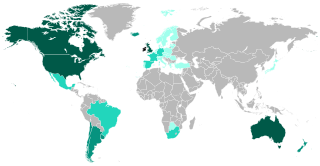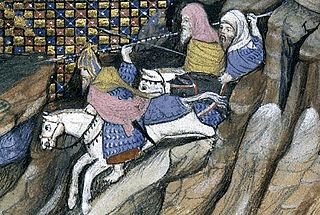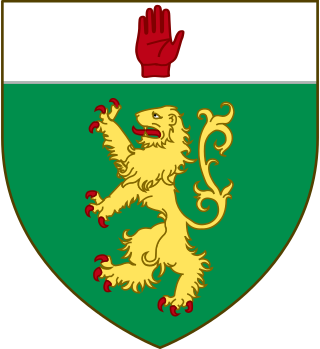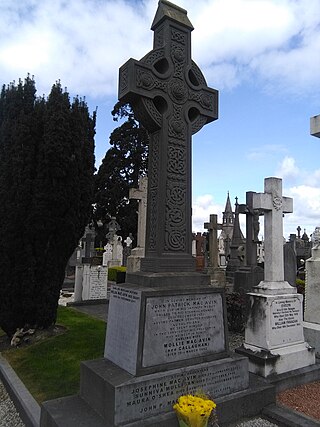Contents
| |||||
| Centuries: | |||||
|---|---|---|---|---|---|
| Decades: | |||||
| See also: | Other events of 1415 List of years in Ireland | ||||
Events from the year 1415 in Ireland.
| |||||
| Centuries: | |||||
|---|---|---|---|---|---|
| Decades: | |||||
| See also: | Other events of 1415 List of years in Ireland | ||||
Events from the year 1415 in Ireland.
Conn Cétchathach, or Conn of the Hundred Battles, son of Fedlimid Rechtmar, was a legendary High King of Ireland who is claimed to be the ancestor of the Connachta, and through his descendant Niall Noígiallach, the Uí Néill dynasties, which dominated Ireland in the early Middle Ages.
Art mac Cuinn, also known as Art Óenfer, was, according to medieval Irish legend and historical tradition, a High King of Ireland.

Shane Patrick Lysaght MacGowan was a British-born Irish singer-songwriter, musician and poet best known as the lead vocalist and primary lyricist of Celtic punk band the Pogues. Known for his songwriting talent as well as his heavy alcohol and drug use, he wrote lyrics that frequently focused on the Irish diaspora experience.
Thomas MacGreevy was a pivotal figure in the history of Irish literary modernism. A poet, he was also director of the National Gallery of Ireland from 1950 to 1963 and served on the first Irish Arts Council.

The Irish are an ethnic group and nation native to the island of Ireland, who share a common ancestry, history and culture. There have been humans in Ireland for about 33,000 years, and it has been continually inhabited for more than 10,000 years. For most of Ireland's recorded history, the Irish have been primarily a Gaelic people. From the 9th century, small numbers of Vikings settled in Ireland, becoming the Norse-Gaels. Anglo-Normans also conquered parts of Ireland in the 12th century, while England's 16th/17th century conquest and colonisation of Ireland brought many English and Lowland Scots to parts of the island, especially the north. Today, Ireland is made up of the Republic of Ireland and Northern Ireland. The people of Northern Ireland hold various national identities including Irish, British or some combination thereof.
The Cath Maige Mucrama is an early Middle Irish language tale which forms part of the Cycles of the Kings.

Art Óg Mac Murchadha Caomhánach was an Irish king who is generally regarded as the most formidable of the later kings of Leinster. He revived not only the royal family's prerogatives, but also their lands and power. During his 42-year reign, he dominated the Anglo-Norman settlers of Leinster. His dominance of the province and its inhabitants, both Gaelic and Hiberno-Norman, was deemed sufficiently detrimental to the colony that Richard II of England spent much of the years 1394 and 1395 sparring with him. While MacMurrough-Kavanagh did eventually submit to Richard, he renounced this fealty on Richard's departure and made much of his kingdom a death trap for any invading English or Anglo-Irish forces. The Crown accordingly dealt with him cautiously and he was granted an amnesty in 1409.
The Uí Ceinselaig, from the Old Irish "grandsons of Cennsalach", are an Irish dynasty of Leinster who trace their descent from Énnae Cennsalach, a supposed contemporary of Niall of the Nine Hostages. Énda was said to be a grandson of Bressal Bélach and a first cousin of Dúnlaing mac Énda Niada, eponymous ancestor of the rival Uí Dúnlainge.

The Kingdom of Breifne or Bréifne, anglicized as Breffny, was a medieval overkingdom in Gaelic Ireland. It comprised what is now County Leitrim, County Cavan and parts of neighbouring counties, and corresponds roughly to the Roman Catholic Diocese of Kilmore. It had emerged by the 10th century, as a confederation of túatha headed by an overking drawn from the Uí Briúin Bréifne.

Magennis, also spelled Maguiness or McGuinness, is an Irish surname, meaning the "son of Angus", which in eastern Ulster was commonly pronounced in Irish as Mag/Mac Aonghusa. A prominent branch of the Uíbh Eachach Cobha, the Magennises would become chiefs of the territory of Iveagh, which by the 16th century comprised over half of modern County Down. By the end of the 17th century, their territory had been divided up between them, the McCartan chiefs and English prospectors.
Events from the year 1395 in Ireland.

Airgíalla was a medieval Irish over-kingdom and the collective name for the confederation of tribes that formed it. The confederation consisted of nine minor kingdoms, all independent of each other but paying nominal suzerainty to an overking, usually from the most powerful dynasty. Airgíalla at its peak roughly matched the modern dioceses of Armagh and Clogher, spanning parts of counties Armagh, Monaghan, Louth, Fermanagh, Tyrone and Londonderry. Its main towns were Armagh and Clogher. The name's usage survives as a cultural area of folk tradition in South East Ulster and adjoining areas of County Louth.
Events from the year 1417 in Ireland.

Josephine "Josie" MacAvin was an Irish set decorator and art director. She won an Academy Award and was nominated two more times in the category Best Art Direction. She also won a Primetime Emmy Award for Outstanding Individual Achievement in Art Direction for a Miniseries or a Special for her work as set dresser on the miniseries Scarlett (1994). MacAvin's Oscar and Emmy statuettes are both on permanent display at the Irish Film Institute, Dublin.
Donnchadh Mac an Caoilfhiaclaigh was a 17th-century Irish poet. The poem Do frith, monuar an uain si ar Éirinn is attributed to him. Do frith links the disunity among Irish, which led to their defeat in the Irish Confederate Wars, with God's displeasure. Part of the poems states:

Iveagh is the name of several historical territorial divisions in what is now County Down, Northern Ireland. Originally it was a Gaelic Irish territory, ruled by the Uí Echach Cobo and part of the overkingdom of Ulaid. From the 12th century the Magennises were chiefs of Iveagh. They were based at Rathfriland and were inaugurated at Knock Iveagh. Following the Nine Years' War, the rulers of Iveagh submitted to the English Crown and the territory was divided between them. Iveagh became a barony, which was later split into Iveagh Lower and Iveagh Upper. The territory of Iveagh was also the basis of the Roman Catholic Diocese of Dromore.
Events from the year 1357 in Ireland.
Events from the year 1375 in Ireland.